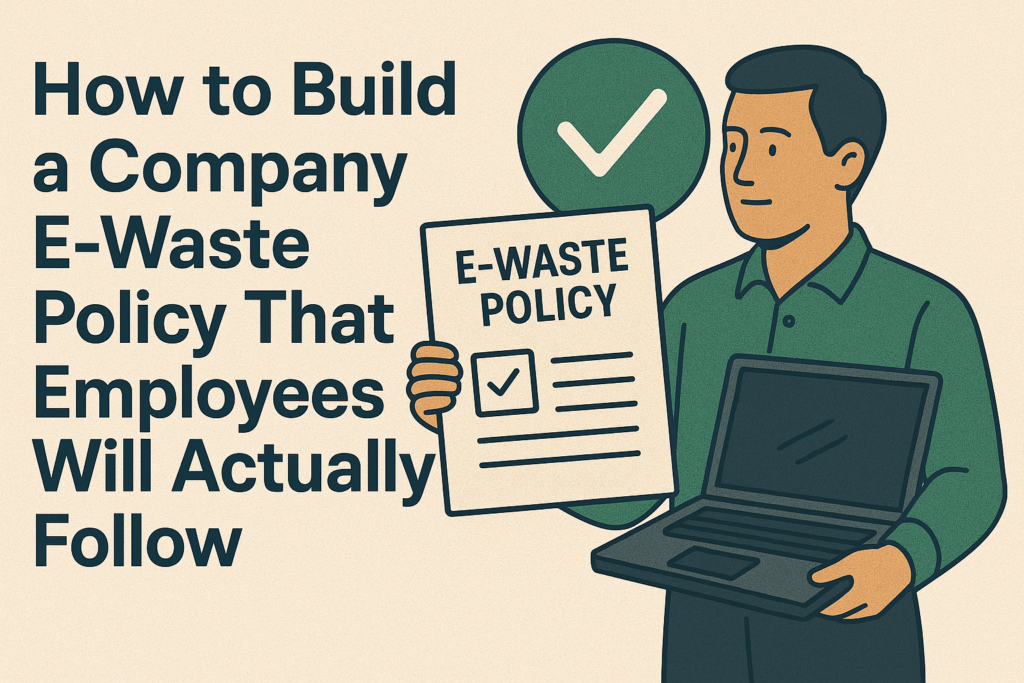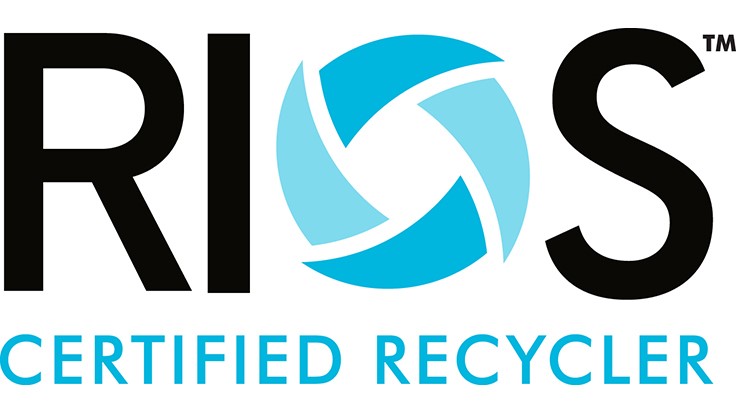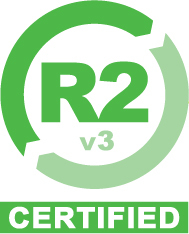
Company e-waste policies often fail because employees find them burdensome. Yet with electronic waste growing rapidly, creating guidelines your team will embrace remains essential for both compliance and environmental protection. Smart policy design transforms e-waste management from a chore into a natural part of workplace culture.
Why Your Company Needs an E-Waste Policy
EPA data shows Americans toss out 2.9 million tons of electronics yearly, with a mere 20% recycled correctly. The rest fills landfills. Meanwhile, manufacturers produced over 300 million computers and 2 billion smartphones in 2014 alone, using scarce metals with limited global supplies.
Smart e-waste management protects company data, meets regulatory requirements like HIPAA and Gramm-Leach-Bliley, supports sustainability goals, and may even generate revenue through remarketing. These policies also signal corporate responsibility to stakeholders who prioritize environmental values.
Key Elements of an Effective E-Waste Policy
1. Clear Classification of E-Waste
Give staff concrete categories defining e-waste items. Include computers, laptops, servers, phones, tablets, storage devices, peripherals, printers, telephones, plus specialized medical or lab equipment.
Provide illustrated examples in your guidelines. Post visual reference charts near disposal areas. Try color-coding different waste types for faster recognition during disposal.
Your system must cover both standard office technology and specialized equipment containing either confidential information or potentially harmful components.
2. Simple Collection Procedures
Build frictionless collection systems for higher participation. Place clearly labeled bins in convenient spots throughout your workspace. Use visibly secure containers for items holding sensitive data.
Keep the documentation quick – aim for 30-second completion times on disposal forms. Set regular pickup schedules but offer on-demand options for bulky items or urgent needs.
Tell staff about collection timing through various channels. Train facilities personnel on proper bin handling to maintain security throughout the disposal process.
3. Data Security Protocols
Security must lead priorities for data-storage devices. Your policy should specify sanitization methods: secure erasure, degaussing, or physical destruction.
Ask staff to back up needed files before turning in equipment. Create verification steps for proving data removal. Document the chain of custody as items move through disposal stages.
Team up with data destruction experts certified in standards like NIST800-88 R1, IEEE 2883-2022, or DOD 5220.22M. Get detailed reports for each processed asset to satisfy compliance requirements.
4. Training and Communication
Introduce e-waste procedures during new hire orientation and refresh concepts in team meetings. Create visual guides with more images than text near disposal stations.
Time reminders around office cleanouts or tech upgrades when disposal volumes typically spike. Publicly recognize teams showing strong compliance.
Recruit e-waste champions from various departments who get extra training and serve as local resources for questions about proper procedures.
5. Transparency in the Process
Staff comply better when they understand what happens after collection. Explain data destruction methods and component recycling processes clearly.
Show environmental benefits using concrete metrics. Highlight regulatory compliance relevant to your industry.
Use flowcharts showing the journey from collection bin to final processing. When people see meaningful outcomes from their actions, participation improves naturally.
6. Make Compliance Easy and Rewarding
Create a drop-off system requiring minimal workflow disruption. Build digital tracking that logs items automatically and generates reports.
Reward high-performing departments with recognition or modest incentives. Share program statistics company-wide to build accountability.
Link e-waste handling to existing systems like IT help desks or facilities requests to prevent it feeling like an extra task.
Implementation Tips for Higher Adoption
Start With Leadership Buy-In
Gain visible executive support before launching. Staff follow leaders who model proper disposal behaviors themselves.
Include executives in kickoff events to demonstrate organizational commitment. Budget adequately for infrastructure, staff time, and vendor partnerships.
Keep program visibility high through periodic leadership team updates.
Incorporate Employee Feedback
Poll staff about barriers to participation and adjust accordingly. Real-world usage insights drive improvements that boost adoption.
Create multiple feedback channels, including anonymous options that capture candid concerns. Review program effectiveness periodically and modify impractical procedures.
Form a cross-departmental committee to evaluate suggestions and refine processes. Distributed ownership creates broader acceptance.
Track and Share Results
Keep detailed records of collection volumes and processing outcomes. This builds accountability and showcases program impact.
Report metrics on recycled weight, remarketed devices, environmental benefits, and departmental participation. Translate statistics into tangible equivalents like trees saved or water conserved to make impact concrete.
Use data to spot trends, fix problem areas, and celebrate wins. Regular performance reporting supports broader sustainability initiatives.
Partner With Certified Specialists
Select experienced recycling partners who understand your regulatory environment. Professional e-waste handlers maintain compliance while supporting environmental goals.
Look for R2/RIOS certification, the gold standard in responsible recycling. These credentials mean your vendor follows protocols protecting against data breaches while practicing environmental stewardship.
Good partners offer complete services: secure transport, verified data wiping, and thorough documentation.
Get Professional Support For Your E-Waste Management
At eWaste Solutions, we help companies build effective e-waste policies that safeguard sensitive information while promoting sustainability. Our services include compliant recycling with comprehensive tracking to support your environmental objectives.
Contact us today to discuss creating an e-waste policy your team will actually follow.
FAQs
What items should be included in a company e-waste policy?
Your e-waste policy should cover all electronic devices and accessories including computers, laptops, tablets, mobile devices, servers, networking equipment, hard drives, keyboards, mice, printers, copiers, telephones, audio/video equipment, medical and laboratory equipment, and any other electronic devices used within your organization.
How do we ensure data security when disposing of electronics?
Proper data security during disposal requires multiple approaches. Professional sanitization options include secure erasure using certified software, degaussing (demagnetizing storage devices), and physical destruction of storage media. The appropriate method depends on security requirements and device type. Always ensure your process complies with standards like NIST800-88 R1 or DOD 5220.22M.
What regulations govern e-waste disposal for businesses?
Businesses must comply with various regulations when disposing of electronic waste. These include HIPAA for healthcare organizations, Gramm-Leach-Bliley for financial institutions, and ITAR for defense-related industries. Additionally, state and federal regulations govern the proper disposal of hazardous materials often found in electronics.
How can we measure the success of our e-waste policy?
Success indicators include the volume of e-waste properly collected, employee participation rates, reduction in improper disposal incidents, and feedback from regular policy audits. Consider implementing quarterly reviews of your program with adjustments based on compliance rates and employee feedback.
Can old electronics generate value for our company?
Yes, through IT asset remarketing. Rather than simply disposing of unused digital devices, professional e-waste management can convert retired equipment into additional revenue. This process involves refurbishing equipment through cleaning and testing, then organizing it by resale potential to maximize compensation.





